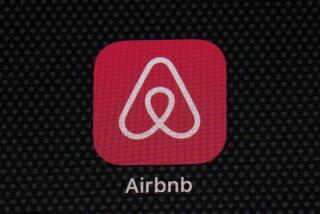Car Rental Customers Shift for Themselves
- Share via
Choosing the best rental car deal used to be terrible, what with having to compare $20 a day and 15 cents a mile with 100 free miles to $17 a day, 20 cents a mile and 75 free miles. Now it’s all “flat rates” and it’s still terrible, but in supposedly better ways.
Everything is special rates and promotions: Almost no one pays the so-called “daily” rate. But now one has to compare all the weekly (five, six, or seven days), weekend, and half-day rates with regional specials and airline and hotel tie-ins, not to speak of the corporate “discount” rates one’s company may have negotiated. “It’s too complicated,” says Jody Tomc, director of system communications for Budget Rent a Car. “It’s byzantine to try to figure it out.”
Big national companies promise that their computers automatically take all time and date information and cough out the best rate--at least for leisure travelers. But most business travelers--who constitute 60% to 80% of the customers of big rental companies--travel on special corporate rates, and these may actually be worse than what’s offered the general public. One such customer who bothered to compare learned that she could have a subcompact from a Hertz office near Boston for Hertz’s standard “affordable rate” of $139 a week (five to seven days, including Saturday night, no Sunday or Monday pickup), compared to the $33-a-day (standard daily rate--$38.99), or $165 just for five days on her special corporate discount.
Rates Depend on Region
Comparisons from rate to rate, never mind from city to city, and company to company, demand a computer, particularly in summer when vacation promotions come thick and fast. Some are weekly rates specific to a region--Hertz’s Ultra Savers ($69 a week in Florida, for example, or $99 in California) and Avis’s SuperValues (same $69 and $99).
Some are weekend rates, generally a bargain for everyone (including those corporate customers who think to ask), so the company can take up the slack left by weekday business travelers. The one exception is New York City, where “the cost of operation is higher,” says Brian Kennedy, Hertz’s senior vice president of marketing, “and where the residents all want the cars on weekends and are willing to pay the price.”
Some are peculiar to one site and particular conditions. Avis, for example, invites people to rent a car in Florida in spring, drive it to New York at $89 for seven days, and return home to Florida on free airline tickets; the routing is reversed in the fall. Avis thus gets its cars into Florida for the winter season, and out during the slack time--a deal “so good that obviously you’re doing Avis a favor,” says Russell James, Avis’s vice president, corporate communications.
The business is basically a price competition, although everyone boasts of their new lineups of sports, luxury and specialty cars, having learned, says Tomc, that people “don’t want to drive the same size or kind of car when they rent.” Still, everybody has such cars, and “for the most part, all are this current model year,” says Tomc, “all are equipped similarly, with every possible piece of equipment, so the only point at which you can compete is price.”
Extras Can Raise Price
For all the talk of “flat” rates, numerous extras can raise the price. Personal insurance and collision coverage can nearly double a bill, as can taking a car from one city to another ($10 a day extra from Hertz, wherever one goes). Then there’s the “refueling surcharge,” a complicated way of billing for the simple task of refilling the tank. What the company sells may not even be a measure of gas, but an estimate: “ Even with eight lanes of gas pumps,” says James, “we can’t fuel it quickly enough to include it in the pricing, so we take the miles you’ve driven and the EPA estimate of the car’s miles per gallon, and the computer calculates the fuel you should have consumed.” (If the customer has put any gas in, the company charges instead by the “tank reading”--again, an estimate of the half or quarter tank required--because the starting mileage no longer represents the last fill-up.)
Other considerations, not immediately apparent, affect the renter’s choice of company--reservations guarantees, for example, which promise that when a customer has reserved a car, he’ll get one. In fact, says Tomc, it is “not the car type that’s reserved, but the rate.” If the requested model isn’t available, the customer is stepped up to “a bigger car at the smaller rate,” says Avis’s James. And if there are no cars left, the company will transfer one from a nearby location, rent one from a competitor, or even, says Kennedy, “buy one off a lot,” if necessary taxiing the customer to his first stop and delivering the car later.
But this doesn’t happen often, says James, given “a computer system, which has the number of cars, the estimated return dates, and tells us when we’re moving into an overbook situation.” So warned, the company can slow down its reservations at that site, or transfer extra cars before they’re needed.
The computers, multiple locations, and size of fleet are probably why the big companies capture most of the rental business. Hertz has 400,000 cars world-wide and 1,800 locations in the U.S. alone; Budget has 110,000 and 1,070 U.S. locations. So while they may not have the best rates (and who can tell?), they will almost surely have the cars.
More to Read
Sign up for The Wild
We’ll help you find the best places to hike, bike and run, as well as the perfect silent spots for meditation and yoga.
You may occasionally receive promotional content from the Los Angeles Times.






